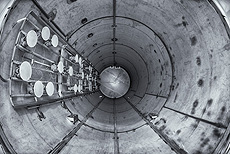LArSoft provides common framework for neutrino experiments
 |
| Several current and future neutrino experiments will use liquid-argon detectors, such as the MicroBooNE detector pictured here, to discover new physics. The LArSoft software package was created specifically for these experiments, including MicroBooNE and the future DUNE and SBND. Photo: Reidar Hahn
|
Liquid-argon time projection chamber (TPC) detectors play a critical role in measuring the properties of neutrinos and their interactions with matter. To maximize physics output and minimize cost, liquid-argon TPC experiments in the United States all share and contribute to a common physics software package, LArSoft.
These experiments include MicroBooNE and the Short Baseline Neutrino Detector (SBND) at Fermilab and the future international Deep Underground Neutrino Experiment (DUNE) in South Dakota.
Before the days of automation, when bubble chambers were used to identify and measure subatomic particles, researchers would take photographs of these chambers and scan for particle interactions by hand. This was less than ideal; events are complicated and difficult to reconstruct, so the process was long and vulnerable to human error.
Now, scientists and engineers have the technology to automate this process. Modern physics software has made it possible to analyze data from more complex experiments such as those in liquid-argon TPCs, where researchers expect to see millions of particle interactions.
LArSoft was created specifically for liquid-argon TPCs and is a tool for event simulation, reconstruction and analysis, making it valuable both before and after experiments take data. It allows rapid processing of each event, and the computations can be divided among the thousands of computers at Fermilab and elsewhere, enormously speeding the process of producing physics results.
Fermilab scientist Brian Rebel initiated LArSoft, and Erica Snider of the Scientific Computing Division is LArSoft manager.
"We will see many more events in our current generation of experiments, making it impractical to scan each one by hand," said David Schmitz, a professor at the University of Chicago and co-spokesperson for SBND.
Scientists across multiple collaborations use the common physics algorithms included in LArSoft. In this respect, it is unique in the particle physics world.
"This is an experiment in software organization since it is unusual for people to share detector simulation or reconstruction codes between collaborations," said Tom Junk, co-coordinator of the reconstruction task force and computing liaison for DUNE.
Sharing software has allowed reduced development time and easy transfer of knowledge between collaborations while encouraging communication across experiments, where interaction may not occur on a regular basis.
"LArSoft provides a platform to graduate students and postdocs that allows them to move across the different experiments," said Sam Zeller, MicroBooNE co-spokesperson. "It really helps with information transfer and allows multiple collaborations to benefit from each other's work."
—Diana Kwon
|